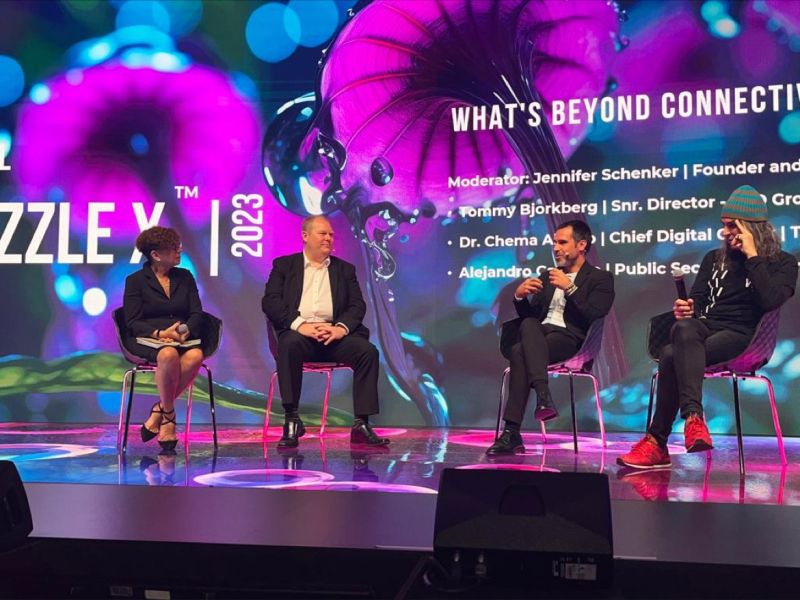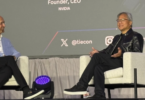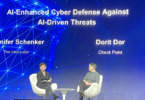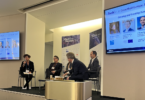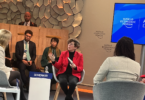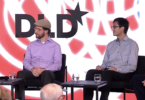PUZZLE X, an annual conference in Barcelona that showcases what’s next in science and technology, this year included everything from fireside chats with Nobel Prize winner Sir Roger Penrose and American geneticist and molecular engineer George Church to a musical performance dubbed The Quantum Symphony of Biology, created from sounds made by a stem cell and gene expression interpreted by a quantum computer.
Quantum computing, AI, the intersection of the two technologies and DNA data storage were key themes at the conference. (The conference featured what was billed as the capturing of attendees’ memories, which Solimán López, founder of the Harddiskmuseum, then stored on single strand of DNA). The Innovator’s editor-in-chief moderated a panel (pictured here) entitled “Beyond Connectivity” which focused on how, with the introduction of 6G, networks will act like a “sixth sense.” Panelists included Chema Alonso, Telefonica’s Chief Digital Officer, Tommy Bjorkberg, Director, CTO Group, ZTE and Alex Carballo, Vodafone’s Public Sector Director.
Read on to get the key takeaways from the conference, which is organized by Zina Cinker, a frontier material expert, strategist, and condensed matter physicist, who currently serves as the Director General of MATTER, an international think tank and association of over 30 country chapters, orchestrating the global use of frontier materials to solve humanity’s most immediate challenges.
Quantum Computing
Scientist Emeritus Joseph Niemela, PhD, talked about the upcoming 100 year anniversary of the discovery of quantum mechanics and an effort by the global scientific community to mark it by having the United Nations proclaim 2025 the international year of quantum science and technology.
Quantum mechanics has led to some of the most profound technological developments of our age: the transistors at the heart of our electronics, the lasers underlying global telecommunication, and the LEDs that have created a revolution in lighting efficiency. “Instead of just looking back we also wanted to look forward,” said Niemela. “Having the United Nations proclaim 2025 the year of quantum computing is a way to raise societal and political awareness of the importance of quantum science and technology for society and the need for investment in education and research in all countries.,” he said. Some 100 scientific organizations are backing the effort as are the governments of 58 countries, including over 20 from Europe. PUZZLE X concluded November 9 with a ceremonial signing of an Open Letter by key international quantum stakeholders to encourage the UN to pass the resolution
Quantum science and technology is expected to be the key cross-cutting scientific field of the 21st century, having a tremendous potential impact on critical societal challenges highlighted by the UN’s 2030 Sustainable Development Goals (SDGs), including climate, energy, food safety and security, and clean water.
For starters, quantum is a lot greener than AI, speaker Roman Orus, PhD, Chief Scientific Officer at Multiverse Computing, told PUZZLE X attendees. “AI is burning the planet faster than airplanes,” he said during his talk. “We need a new method of computing in order to make it greener and more sustainable.”
Given the expected shortage of quantum experts several speakers emphasized the importance of training children from a young age to become citizen scientists. Speaker William Hurley, commonly known as whurley, an American tech entrepreneur and investor, talked about his two books: Quantum Computing for Babies and another called Quantum Computing for Dummies. Bob Coecke, PhD, the Chief Scientist at Quantinuum, presented a book he co-authored called Quantum in Pictures that explains quantum theory through drawings of color coded spiders. Coecke, who taught quantum at Oxford University for 20 years, designed a mini course on quantum based on sketches. He used these sketches to communicate the same subject material taught to post-doc students at Oxford. As part of an experiment Coecke advertised a free course for high school students. One thousand responded; sixty were randomly chosen. Sixty percent of the students, aged 15-17, passed with distinction, proof, says Coecke, that you don’t need to be strong in math to grasp how it works.
“We want to teach everyone quantum,” says Coecke, who emphasized the importance of democratizing the technology. “We don’t want to find ourselves in the same situation as AI,” he says, with a handful of companies controlling the market.
No one knows for sure when the quantum advantage will become a reality. When it does the impact will be swift and create winners and losers. In a talk entitled “The Next Trillion Dollar Opportunity in Quantum Finance” McKinsey Partner Henning Soller talked about how finance will be one of the key industries to benefit from quantum computing. The biggest benefits will be for corporate banking and risk and cybersecurity, he says. Quantum will allow better calculations on the risk size and allow banks to drill down to the individual asset level to analyze the impact of certain trades in real time. Quantum will also offer huge efficiency gains, he said. Soller urged companies not to wait. “Hybrid systems are here now, quantum is becoming real, not just for banking,” he said. “One-third of our clients already have use cases in production.”
During the conference two startups, Terra Quantum and SandboxAQ, talked about their hybrid solutions that run today on classical computers, while the development of quantum hardware proceeds. Terra Quantum, which is co-headquartered in St. Gallen, Switzerland and Munich, Germany is targeting the energy, financial services, automotive and life sciences sectors. Customers include HSBC, Thales Group and Volkswagen.
The advantages of using a hybrid approach include better answers for complex optimization problem, said speaker Markus Plitsch, CEO and Chairman of Terra Quantum.
AI + Quantum
“LLMs [AI large language models] are creating waves in business and society due to their ability to do pattern recognition across massive data sets however they do have limitations,” said Plitsch. “They lack human judgment and creative thinking, struggle what is true and are constrained by deterministic programming rules which means their true imaginative capacities are limited. These models could be advanced with exponential capabilities.”
Quantum computing, which he called “the most disruptive tech for the next century” is the answer, said Plitsch, because the technology is non-deterministic. The combination of Quantum and AI “will harness uncertainty to drive true creativity,” he said.
Artificial Intelligence: Six Business Models For The Future
Brian Subirana, a Professor of Artificial Intelligence at M.I.T, Harvard University and EADA Business School, predicted that six business models for AI will emerge around the following areas:.
- Healthcare Longitudinal Diagnosis covering the whole human, rather than just a particular organ or disease.
- Signal Processing: Using signals in the air to determine what humans are doing, such as monitoring the elderly for falls.
- Internet of Things: Tiny antennas on sensors will start to do processing, including under water, to do a number of things, including harvesting energy from sound.
- Ingestible robots. Mini robots that humans eat will emit signals outside to let us know what is going on inside the body.
- Robotics: The application of AI to robotics
- Bioengineering, the application of engineering principles to improve disease prevention and treatment, agricultural production, energy sustainability, and more.
DNA Storage
The idea of using DNA as a medium for storing digital information was first suggested in 1959 by the American physicist Richard Feynman, who was awarded the Nobel Prize in Physics in 1965. Breakthroughs announced in the last few months underscore the progress being made to turn the vision into reality. There is a big incentive. In 2020, humanity produced 45 zettabytes of digital data, according to CRNS, France’s national scientific research organization. This volume should amount to 175 Zb by 2025. Faced with this staggering increase, today’s storage media (optical, magnetic tape, and hard drives) appear to have reached their limits: they are fragile, with a life expectancy of 5-7 years; the energy-hungry data centres housing them now consume nearly 2% of global electricity production; and they take up space, with the ever-growing surface they cover now “The extending to 167 kilometers worldwide.
“The world is producing data all the time not just exponentially but hyper exponentially,” speaker Rob Carlson, Managing Director of Planetary Technologies, said in an interview with The Innovator. “Technologies we use to store data won’t be able to do so much longer.”
At PUZZLE X three startups talked about their efforts to enable the storing of data and computing within synthetic DNA: Catalog DNA, Twist Bioscience and , Cache DNA, a spinout from Mark Bathe’s lab at MIT and a National Science Foundation (NSF) grant recipient.
DNA promises to not only be a reliable medium for storing data long term but also to help advance drug discovery and personalized medicine. Cache DNA, for example, is using a proprietary molecular barcoding and encapsulation technology that allows DNA to be used as a scalable platform for handling nucleic acids critical to areas like biobanking, biopharmaceutical library assets and personalized medicine. The company’s scientific advisors include Mark Bathe, an American biological engineer working on DNA nanotechnology and co-founder of Cache DNA and Kano Therapeutics, Paul Blainey, an American technologist and serial entrepreneur, George Church, an American geneticist, molecular engineer, chemist, serial entrepreneur, and pioneer in personal genomics and synthetic biology, and Jeremiah A. Johnson, an American chemist working on synthetic polymers.
Creating Electricity From Air
Materials scientist Svitlana Lyubchyk and her twin son Andriy and Sergiy did a demo of technology they developed which allows direct conversion of humidity in the air into electricity. The trio, who co-founded Lisbon-based CascataChuva, are not alone in their attempts to change atmospheric humidity into renewable energy but the company says it is poised to become the first to commercialize the technology. By the end of next year, the company hopes to begin producing a one-cubit meter sized device that can produce 10 kilowatts of electrical energy a day – enough to power the needs of one household up to 200 square meters – for 20 years or more. The devices will be designed to power individual apartments and places that can’t use solar energy.
Applying Cutting Edge Tech To The World’s Most Pressing Problems
Several sessions focused on how to apply cutting-edge technologies to some of the world’s most pressing problems. Twelve students from The Knowledge Society (TKS) a 10-month global innovation program for ambitious high school students, participated in the conference. Conference participants included Annie Zountsa, a 15-year-old Greek. She, together with three other young women from Turkey, the UK and Canada, are working on a moonshot project called Oasis that aims to make clean water as abundant as air. Oasis uses hydrogels and hygroscopic salts to attract water in the air, then captures the water molecules inside a solar-powered box and turns them into safe, drinkable water. Naila Moloo, a 17-year-old high school student from Canada, gave a talk about work she is doing to make solar cells light and flexible enough to integrate into cars, cell phones or the fabrics we wear. (Both projects are looking for funding)
To access more of The Innovator’s Key Takeaways articles click here.

